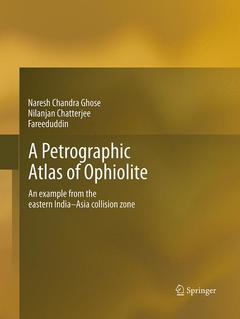Description
A Petrographic Atlas of Ophiolite, Softcover reprint of the original 1st ed. 2014
An example from the eastern India-Asia collision zone
Authors: Ghose Naresh Chandra, Chatterjee Nilanjan, Fareeduddin
Language: English
Subject for A Petrographic Atlas of Ophiolite:
158.24 €
In Print (Delivery period: 15 days).
Add to cartPublication date: 10-2016
Support: Print on demand
158.24 €
In Print (Delivery period: 15 days).
Add to cartPublication date: 01-2014
234 p. · 21x27.9 cm · Hardback
Description
/li>Contents
/li>Biography
/li>Comment
/li>
Introduction.- Ophiolite around the Indian Plate Margin.- Geology of the Naga Hills Ophiolite.- Structure and Tectonics of the Naga Hills.- Petrography.- Petrogenesis.
Prof. N.C. Ghose, born in Uttarpara near Kolkata on 18 June 1940, obtained M.Sc. in 1961 and Ph.D. in Geochemistry in 1964 from Banaras Hindu University, Varanasi, India. He joined Patna University in 1965 and retired as a Professor in 2000. As a fellow of the Alexander von Humboldt Foundation, he pursued research in Gottingen (1972–73) and Karlsruhe (1978–79) on “Experimental Melting of Granite System”. He has determined the Eutectic composition and Temperature in the system “Quartz–Orthoclase–Anorthite” at 4 and 7 kbars (1973), which has wide implication in crustal melting. He extended the melting experiment studies to natural rocks ranging from gneisses and granites from the Darjeeling Himalaya, Chotanagpur gneisses to the migmatites of South Norway (Dypvag). Prof. Ghose has worked in the field of Earth and Environmental Sciences and authored 7 books and published 90 original research papers in peer reviewed journals. His contributions in the fields of Proterozoics of Chotanagpurgneisses, Massif anorthosite of Bengal, Rajmahal basalts and the Ophiolites of Naga Hills are widely acclaimed. He has published original research papers and books on Pollution of chemical, bacteriocidal and radioactive (radon) constituents of River Ganga in the Mid-Ganga Basin (1989), Groundwater Resources of Patna urban conglomerate (1992), Iodine contents of soil–water–plant in the Gangetic Plain of North Bihar (2003), and Synthetic Detergents (surfactants) and Organochlorine Pesticides in the Surface water and Groundwater of the Deltaic region of Bengal (2009), used in the fields of science, medicine, town planning and social work.
Dr. Nilanjan Chatterjee received his Ph.D. in Geochemistry from the City University of New York in 1989. His high school and undergraduate education was in India. He is currently employed as a Principal Research Scientist in the Department of Earth, Atmospheric and Planetary Sciences at the Massachusetts Institute of Technology (MIT), Cambridg



